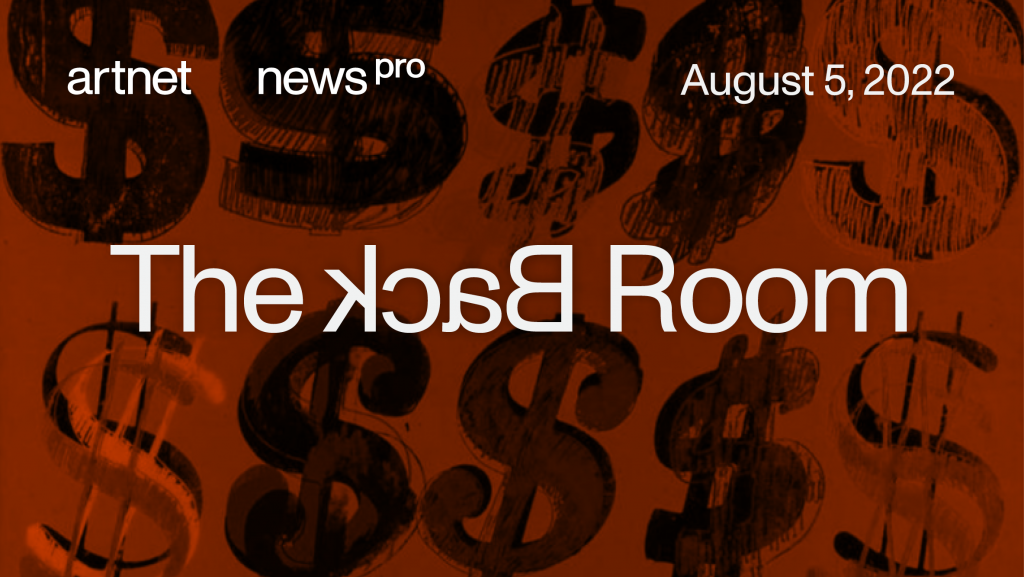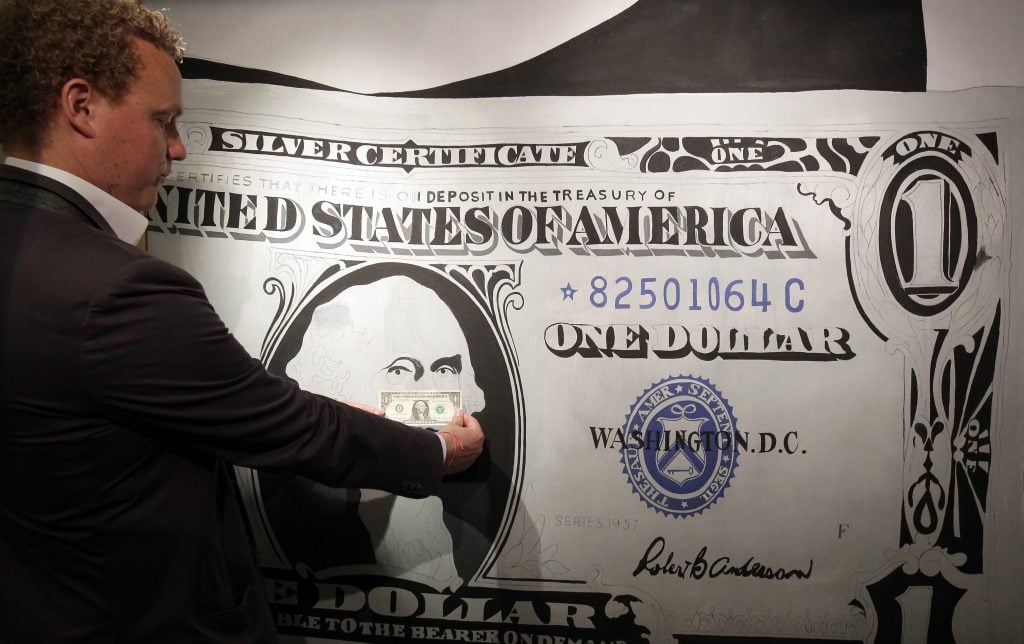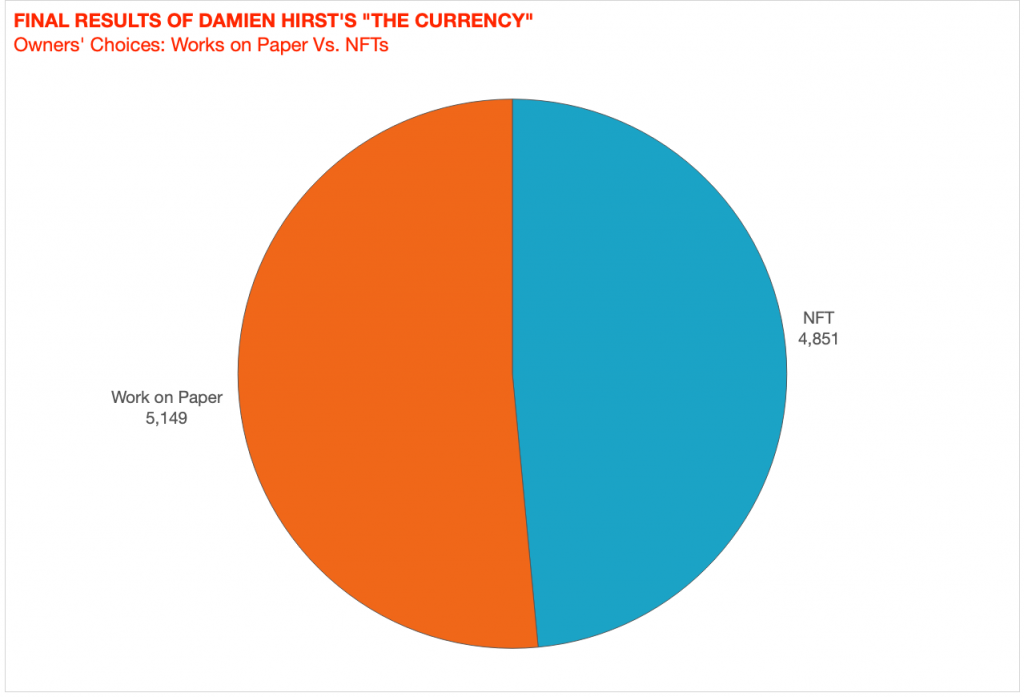The Back Room
The Back Room: Dollar Days
This week: the U.S. dollar flexes its muscle, the Hamptons get scandalous, "The Currency" maths out, and much more.

This week: the U.S. dollar flexes its muscle, the Hamptons get scandalous, "The Currency" maths out, and much more.

Tim Schneider &
Naomi Rea

Every Friday, Artnet News Pro members get exclusive access to the Back Room, our lively recap funneling only the week’s must-know intel into a nimble read you’ll actually enjoy.
This week in the Back Room: the U.S. dollar flexes its muscle, the Hamptons get scandalous, “The Currency” maths out, and much more—all in a 6-minute read (1,614 words).
________________________________________________________________________________________

Andy Warhol’s One Dollar Bill (Silver Certificate) (1962) shown at the media preview of the summer auction at Sotheby’s Hong Kong in May 2015. (Photo by Dickson Lee/South China Morning Post via Getty Images)
The U.S. dollar is the strongest it has been in two decades. What does this mean for the art market? The answer is more nuanced than you might think, according to Katya Kazakina.
As of last Friday, the greenback was up 10 percent YTD against a basket of currencies including the euro and the pound sterling. Globally, that has resulted in a “trail of devastation,” Bloomberg reporters wrote recently. The fallout has stretched from rising costs for food imports, to deepening poverty around the world, to a hand in the toppling of Sri Lanka’s government.
The dollar’s strength is the result of the Federal Reserve’s attempts to stall inflation by raising interest rates, with the latest hike announced last week. The bump warrants reviewing at least three lessons about the global art trade in a period of USD dominance…
Factoring in private and public sales, the U.S. has been the largest art market for decades, and its buying power only swelled this year due to currency fluctuations.
Yankee buyers represented 44 percent of the $3.5 billion in global auction sales at Christie’s in the first half of 2022—the highest percentage in seven years, according to Bonnie Brennan, the company’s president of the Americas. U.S. buying abroad was up 35 percent compared to the same period in 2021, she said.
What does this mean in practice? Well, an American buyer recently snapped up a large-scale painting by Yves Klein for £27.2 million ($33.4 million on the day of sale) at Christie’s 20th and 21st century evening sale in London. That’s a major increase from the presale estimate of £24 million for anyone paying in pounds—but an extreme discount for anyone paying in dollars.
How extreme? A year earlier, the same purchase would have equated to $37.8 million for a dollar-denominated bidder. That means a delta of $4.4 million.
The flip side of this scenario is a disadvantage for foreign collectors vying for works sold by U.S. dealers and/or U.S. artists. Setting aside the unfavorable currency conversion, many artists prefer to be paid in the currency of their home country regardless of larger circumstances. So, buying an American artist’s work from a European or Asian dealer now means a significant up-charge.
And yet…
This debate is distorted somewhat by a simple fact: many, if not most, people buying art are already within the 0.1 percent of top earners worldwide (aka the peak of the investor class).
As a result, shifts in the global currency market have already been factored into their overall investment strategy by savvy portfolio managers. To these collectors, the dollar’s rise has been no impediment to new acquisitions.
“If you offer me a great Picasso, I won’t ask you if it is in Swiss Francs or U.S. dollars or British pounds,” collector-dealer David Nahmad said. “I will buy it no matter what. And I am not going to stop because of a 10 percent devaluation or appreciation.”
Due to inflation, a COVID-era transport backlog, and the ongoing war in Ukraine, shipping prices have “at least doubled since before the pandemic, according to collectors and advisors,” Katya wrote.
That’s a much larger percentage jump than the modest one precipitated by the dollar’s rise. Which means that alternate factors could compel even U.S.-based collectors to blanch at the cost of acquiring new work in the near future.
Scarier still might be the second-order effects of the macroeconomic environment. Foremost among them: a drastic tightening of supply of top-tier works. Nahmad, for one, deemed it “almost impossible to get great collections” in this environment.
Without elite-level pieces to tempt buyers, then, macroeconomic conditions could be enough to (finally) chill an overheated market.
________________________________________________________________________________________
A strong U.S. dollar has historically benefited blue-chip works, according to auction executives. When currency-market fluctuations mean every buck counts more than ever, collectors have shown a tendency to retreat to quality no matter where in the world they are based.
Yet this longstanding trend also sets up a reckoning for the art market as a whole. In theory, the dollar’s bounceback should correct months (if not years) of frothy prices for a new generation of emerging stars.
If it doesn’t, however, the results will signal either a fundamentally different mindset among the buyers propelling the most headline-grabbing elements of the trade—or evidence that interest rates will have to soar even higher to convince collectors we’ve reached the top of the speculative market.
________________________________________________________________________________________

Noodlerice, We Can’t Wait Much Longer at the Watermill Center. Photo by Laura Brichta, courtesy of the Watermill Center, Water Mill, New York.
Later today, the latest Wet Paint will track the curious case of New York socialite Stacy Engman being “walked out” from the annual benefit party at the Watermill Center by her own security detail over a kerfuffle.
Plus, a sneak peek at all-time great Laurie Anderson’s new series of paintings, and the resolution of an odd controversy over an alleged fake Nicolas Party work.
Here’s what else made a mark around the industry since last Friday morning…
Art Fairs
The inaugural edition of Design Miami Paris was postponed due to local authorities’ safety concerns over the prospect of “demonstrations of the ‘yellow vests’ type” near its venue, the Place de la Concorde. (Artnet News)
Auction Houses
Phillips and London dealer The Artist Room will open a joint pop-up in Seoul’s Lee Eugean Gallery from August 21–September 6. The show will preview works to be offered in a selling exhibition debuting at Phillips Hong Kong September 19. (Press release)
Galleries
David Kordansky will pop up in Seoul from August 18–September 5 to showcase gallery artists ranging from John Armleder to Shara Hughes. The show will take place at 157 Itaewon-ro 55-gil in the Yongsan-gu neighborhood. (Press release)
Hauser and Wirth has renewed the lease on its Southampton location for another three years. It opened the space on Main Street in the summer of 2020. (Artnet News)
Institutions
The Met announced that director Max Hollein will also assume the role of CEO upon the departure of Daniel Weiss next summer. (Artnet News)
The forthcoming Rubell Museum in Washington, D.C. appointed Caitlin Berry its inaugural director. Berry, the former director of Marymount University’s Cody Gallery, will take up the post this month in advance of the museum’s October 29 debut. (Press release)
Legal Corner
In a surprise ruling, a Swiss court reopened an investigation into Yves Bouvier over his dealings with Russian billionaire Dmitry Rybolovlev. (Artnet News)
________________________________________________________________________________________
“I don’t understand the desire for these galleries to provide everything. It’s very interesting to me and is a weird psychology. ‘I want to be your gallerist in L.A., New York, Paris, Shanghai.’ What’s up with that? It’s also very colonizing. How can one gallery be an expert in all those places?”
—JTT gallery founder Jasmin Tsou on the resistance some galleries (especially at the high end) show toward partnering with dealers in other markets to represent artists. (Artnet News Pro)
________________________________________________________________________________________

© 2022 Artnet Worldwide Corporation.
The would-be-bad-boy hook of Damien Hirst’s NFT project “The Currency” was that every buyer would have to make a choice: trade in their NFT for the physical work on paper from which it was digitized, or keep the NFT and allow Hirst to literally burn the corresponding drawing. The results are now in, but they’re less conclusive than they might appear…
For more background on Hirst’s crypto provocation, click through below.
________________________________________________________________________________________